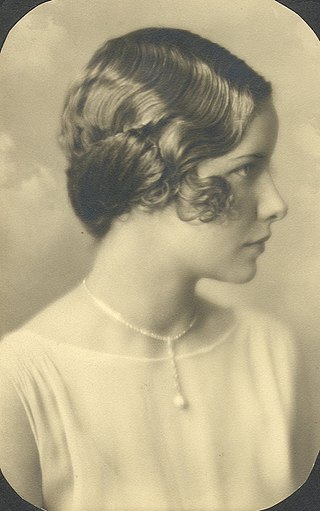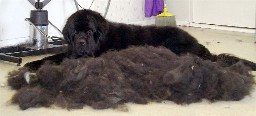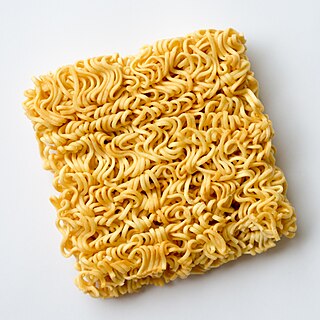Related Research Articles

A hairstyle, hairdo, haircut or coiffure refers to the styling of hair, usually on the human head but sometimes on the face or body. The fashioning of hair can be considered an aspect of personal grooming, fashion, and cosmetics, although practical, cultural, and popular considerations also influence some hairstyles.

A hygrometer is an instrument which measures the humidity of air or some other gas: that is, how much water vapor it contains. Humidity measurement instruments usually rely on measurements of some other quantities such as temperature, pressure, mass and mechanical or electrical changes in a substance as moisture is absorbed. By calibration and calculation, these measured quantities can lead to a measurement of humidity. Modern electronic devices use the temperature of condensation, or they sense changes in electrical capacitance or resistance to measure humidity differences. A crude hygrometer was invented by Leonardo da Vinci in 1480. Major leaps came forward during the 1600s; Francesco Folli invented a more practical version of the device, while Robert Hooke improved a number of meteorological devices including the hygrometer. A more modern version was created by Swiss polymath Johann Heinrich Lambert in 1755. Later, in the year 1783, Swiss physicist and Geologist Horace Bénédict de Saussure invented the first hygrometer using human hair to measure humidity.

A semi-arid climate, semi-desert climate, or steppe climate is a dry climate sub-type. It is located on regions that receive precipitation below potential evapotranspiration, but not as low as a desert climate. There are different kinds of semi-arid climates, depending on variables such as temperature, and they give rise to different biomes.

A finger wave is a method of setting hair into waves (curls) that was popular in the 1920s and early 1930s and again in the late 1990s in North America and Europe. Silver screen actresses such as Josephine Baker and Esther Phillips are credited with the original popularity of finger waves. In their return in the 1990s, the style was popularized by pop stars like Madonna, and hip-hop stars of the time, such as Missy Elliott. The popularity of finger waves in the 1990s was aided by a movement toward shorter, more natural hair in the African-American community. This also was a common hairstyle worn by slaves back in 1802 through generations to 1889 and only began to take effect of popularity when Bette Davis danced on Sugar be mine live television.

A hair dryer, hairdryer, hairdrier or blow dryer is an electromechanical device that blows ambient or hot air over damp hair to speed the evaporation of water to dry the hair. Blow dryers enable better control over the shape and style of hair, by accelerating and controlling the formation of temporary hydrogen bonds within each strand. These bonds are powerful but are temporary and extremely vulnerable to humidity. They disappear with a single washing of the hair.

A permanent wave, commonly called a perm or permanent, is a hairstyle consisting of waves or curls set into the hair. The curls may last a number of months, hence the name.

A bathrobe, also known as a housecoat or a dressing gown, is a loose-fitting outer garment worn by people, often after washing the body or around a pool. A bathrobe is considered to be very informal clothing, and is not worn with everyday clothes.

A horse blanket or rug is a blanket or animal coat intended for keeping a horse or other equine warm or otherwise protected from wind or other elements. They are tailored to fit around a horse's body from chest to rump, with straps crossing underneath the belly to secure the blanket yet allowing the horse to move about freely. Most have one or two straps that buckle in front, but a few designs have a closed front and must be slipped over a horse's head. Some designs also have small straps that loop lightly around the horse's hind legs to prevent the blanket from slipping sideways.
A relaxer is a type of lotion or cream generally used by people with tight curls or very curly hair which makes hair easier to straighten by chemically "relaxing" the natural curls. The active agent is usually a strong alkali, although some formulations are based on ammonium thioglycolate or formaldehyde.
Artificial hair integrations, more commonly known as hair extensions, hair weaves, and fake hair add length and fullness to human hair. Hair extensions are usually clipped, glued, or sewn on natural hair by incorporating additional human or synthetic hair. These methods include tape-in extensions, clip-in or clip-on extensions, micro/nano rings, fusion method, weaving method, and wigs.
Dread perming is a chemical treatment that is used both by beauty salons and do-it-yourselfers to create or maintain dreadlocks. The hair is exposed to chemicals that render the hair frizzy. The frizzy hair is bound together and treated again to form the dreadlocks.

Charles Nessler was the inventor of the permanent wave.

Dog grooming refers to both the hygienic care and cleaning of a dog, as well as a process by which a dog's physical appearance is enhanced for showing or other types of competition. A dog groomer is a person who earns their living grooming dogs.

A hair roller or hair curler is a small tube that is rolled into a person's hair in order to curl it, or to straighten curly hair, making a new hairstyle.
Hairstyling tools may include hair irons, hair dryers, hairbrushes, hair rollers, diffusers and various types of scissors.

The Jheri curl is a permanent wave hairstyle that was popular among African Americans during the 1980s and early 1990s. Invented by the hairdresser Jheri Redding, the Jheri curl gives the wearer a glossy, loosely curled look. It was touted as a "wash and wear" style that was easier to care for than the other popular chemical treatment of the day, the relaxer.

Instant noodles, or instant ramen, is a type of food consisting of noodles sold in a precooked and dried block with flavoring powder and/or seasoning oil. The dried noodle block was originally created by flash-frying cooked noodles, and this is still the main method used in Asian countries; air-dried noodle blocks are favored in Western countries. Dried noodle blocks are designed to be cooked or soaked in boiling water before eating. Ramen, a Japanese adaptation of Chinese noodle soup, is sometimes used as a descriptor for instant noodle flavors by some Japanese manufacturers. It has become synonymous in the United States with all instant noodle products.

Iranian traditional medicine (ITM), also known as Persian traditional medicine, is one of the most ancient forms of traditional medicine.

The Curly Girl Method is an approach to hair care designed by author Lorraine Massey for natural hair that has not been chemically relaxed. This method discourages the daily use of sulfate shampoo, which is considered too harsh for curly hair. Among other things, it calls for the use of a cleansing conditioner in place of shampoo, no silicones, the use of a diffuser when blowdrying, and no combs, brushes, or terrycloth towels. It also includes tips for using hair gel and other styling products. The aim in general is to treat naturally curly hair gently, minimizing damage to the hair cuticle; to keep it moisturized, since curly hair is more prone to dryness than straight hair; and, perhaps most significantly, to accentuate rather than interfere with the hair's natural curl pattern.

Frizz is hair that does not align with the surrounding hair, but stands up or curls independently, creating a fuzzy or irregular texture. The three main causes of frizz are genetics, hair damage, and humidity. Frizzy hair can be seen as a positive or a negative trait depending on the current fashion and one's personal preference. Many hair products, such as gels, pomades, and hair waxes, are designed to reduce frizz.
References
- ↑ Hughes, Sali. "Sali Hughes: digital perms", The Guardian, 13 July 2012.
- ↑ "Paimore Ltd. website in Japan". Archived from the original on 2009-02-07. Retrieved 2008-09-06.